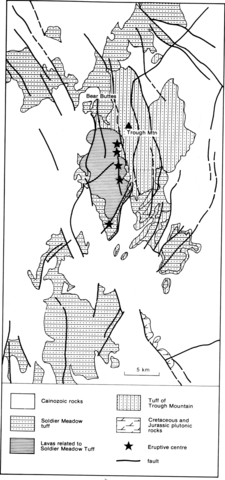stripes
The Soldier Meadow peralkaline tuff and associated lavas were erupted from a linear vent area of five identified eruptive centres. The tuff overlies the tuff of Trough Mountain, which is also peralkaline, and in the northern part of its outcrop is cut by dykes and overlain by domes and flows of subalkaline and peralkaline silicic rocks. The Soldier Meadow tuff is a multiple ash-flow sheet exposed over an area of about 1500 km2 and varying widely in thickness, mainly reflecting the earlier topography. The lowest member of the unit is an ash-flow deposit with an original volume of some 50 km3. Near the eruptive vents this is overlain by up to 60 m of non-welded to densely welded air-fall tuff, which in turn is overlain and intruded in the vent area by lavas. All units are similar in appearance, petrography and chemistry except that the lavas lack eutaxitic textures but show flow structures. The rock contains 13% sanidine and 9% quartz phenocrysts, less than 1% each of ferrorichterite, sodic ferroaugite, magnetite, ilmenite and rare aenigmatite, zircon and biotite in a fine granophyric groundmass. Chemically the rock is a comendite. Peralkaline rhyolite intrudes the Soldier Meadow tuff at Bear Buttes to the north, and similar lavas occur to the north and northwest (Korringa, 1973, p. 3862). The tuff of Trough Mountain is also comenditic and contains rare sodic amphibole. Chemical analyses will be found in Korringa (1973, Table 1) and minor elements, including REE data, in Noble et al. (1979, Table 2). The distribution and mobility of U and Th in the Soldier Meadow tuff have been investigated by Stuart et al. (1983) and the general stratigraphic context in relation to the volcanic rocks of northwest Nevada is discussed by Noble et al. (1970).
KORRINGA, M.K. 1973. Linear vent area of the Soldier Meadow tuff, an ash-flow sheet in northwestern Nevada. Bulletin of the Geological Society of America, 84: 3849-66.
NOBLE, D.C., MCKEE, E.H., SMITH, J.G. and KORRINGA, M.K. 1970. Stratigraphy and geochronology of Miocene volcanic rocks in northwestern Nevada. Professional Paper, United States Geological Survey, 700-D: 23-32.
NOBLE, D.C., RIGOT, W.L. and BOWMAN, H.R. 1979. Rare-earth-element content of some highly differentiated ash-flow tuffs and lavas. Special Paper, Geological Society of America, 180: 77-85.
STUART, E.J., BORNHORST, T.J., ROSE, W.I. and NOBLE, D.C. 1983. Distribution and mobility of uranium and thorium in the peralkaline Soldier Meadow tuff, northwestern Nevada. Economic Geology, 78: 353-8

